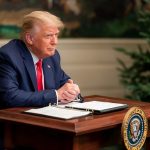President Trump stirred the pot of the educational establishment by signing an executive order aimed at dismantling the federal Department of Education, convincing states that they can handle education better—presumably because they actually live there. This announcement came as the President told the media during a recent Cabinet meeting that Americans should brace for “tremendous change” in education that will come at a speed reminiscent of a racehorse out of the gate.
Historically, states have managed their own education systems with a whopping 90% of funding sourced from state and local taxes. Despite this, the federal folks in Washington have thought they knew better—because obviously, what do local governments know about their own educational needs? Apparently, stripping away federal control and letting states step up means they can finally get down to the nitty-gritty of educating future generations without the bureaucratic red tape tying them down.
In typical government fashion, while Trump’s Cabinet meeting was in full swing, workers at the Education Department were told to pack their bags—not exactly a heartwarming farewell. With a mere 30 minutes to wrap it all up, one could almost hear the collective groans of employees realizing they’d have to clear out their desks faster than they could say “job security.” Advocacy and labor groups—which, of course, always know what’s best for students—immediately sprung into action to file a lawsuit, claiming that the executive order is unconstitutional and detrimental to students. It’s amusing how those who are most entrenched in the system suddenly become champions of children’s rights when it suits their agenda.
Trump says states already implementing changes from his order to shut Education Departmenthttps://t.co/dDO9WHzwGd pic.twitter.com/ItxuYIrFYS
— The Washington Times (@WashTimes) March 25, 2025
Turning student loans over to the Small Business Administration sounds like an efficient move. Trump assured the public that the transition would be handled “very professionally,” which is just code for “we won’t be using the same methods that got us into messes before.” The Department of Health and Human Services is set to take over the more medical side of education—because who doesn’t love a little health oversight mixed with reading, writing, and arithmetic? Meanwhile, it seems there is an eager line of states just waiting to get their hands on the educational records of their students, presumably to ensure they’re receiving the best education possible and not transferring useless politicking along with it.
Trump also reassured teachers—those inadvertently welcomed heroes of the education system—that their interests will be taken very seriously, regardless of union affiliation. His comments seemed to imply that what matters most is the quality of education, rather than the politics of the teachers’ unions, a bold stance that should send shockwaves down the spine of the well-established entities that have held sway for decades.
Education Secretary Linda McMahon showed her alignment with the President’s vision, stating that fixing the education system is crucial for ensuring the future of the nation’s generations. Her renewed focus on local control could just be what the doctor ordered for an ailing system. If states have the autonomy to make real changes, they might actually just surprise everyone with a few innovative methods that Washington wouldn’t dare dream up. Maybe it’s time to let go of the traditional approach and embrace a future where states can finally take pride in their responsibility for educating the youth, free from the clutches of federal oversight.




